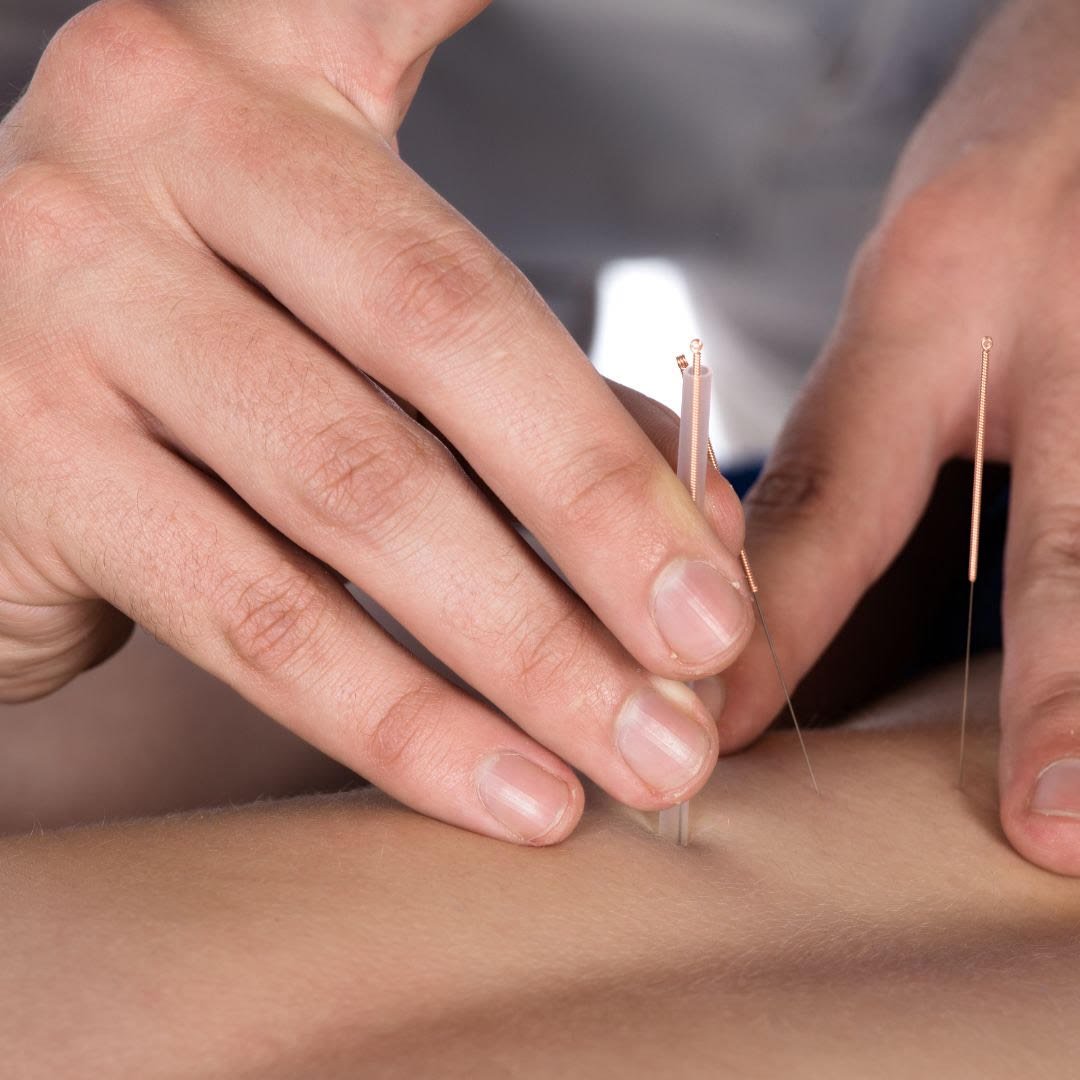Acupuncture: Where Ancient Philosophy Meets Modern Science
EVOLVE Flagstaff began offering acupuncture services in 2023, and consider it an invaluable tool to managing many types of pain and dysfunction. But, we find that acupuncture is commonly misunderstood. In this article, we break down acupuncture’s history, how it works, what it can help with, and what your first treatment might be like.
What is acupuncture and how does it work?
Simply put, acupuncture is a medical treatment modality that can treat pain and help with nervous system regulation. It uses very thin needles inserted in targeted points in the body. These points are not chosen at random, but selected by your acupuncture provider according to your symptoms, and a detailed assessment that considers your muscles, joints, nerves, and overall nervous system.
Stimulation from a needle creates a cascade of events in the injured tissue which results in a response from the central nervous system.There’s a number of complex chemical compounds involved, with names like “ calcitonin gene-related peptide,” “beta-endorphins,” and “enkephalin.” The net result is that there is an increase in blood flow at the injured area and an increase in release of red and white blood cells. This helps with healing. Studies have also shown a release of chemicals at the level of the brain and spinal cord in response to acupuncture needles that decrease pain. All of this combined means that you feel and move better.
(And no, we don’t needle your brain or spinal cord - the release of chemicals comes from the cascade of events stimulated by skillfully placed acupuncture needles.)
Modern peer-reviewed studies have proven that acupuncture can be effective in treating a variety of conditions such as neck or back pain, insomnia, and migraines. For the science-inclined folks out there, you can check out a summary with links to more details at Evidence-Based Acupuncture.
This is Jon, our licensed Acupuncturist. He’d love to help you!
Sidebar: What is the nervous system?
Let’s take one step back and quickly discuss the nervous system, as it is essential to understanding acupuncture. We use the term “nervous system” a lot, but what does it mean? The nervous system is like the operating system of your body, similar to Windows or MacOS on your computer. It runs everything that goes on in the background, such as circadian rhythms, digestion, heart rate, blood pressure, hormone release, and much more.
There are two parts to the nervous system, the parasympathetic system, often called the “rest and digest” system that helps you relax, digest food, calm down, and fall asleep. The sympathetic system, or “fight, flight or freeze” system is responsible for your responses to stress - increasing tension, blood pressure, and more.
We need a balance between the parasympathetic and sympathetic systems. In today’s world, we often see the sympathetic system going into overdrive, which can cause all sorts of pain, digestion issues, sleep disruption, mental health difficulties. Treatment modalities like acupuncture that promote parasympathetic activity can have powerful positive effects.
Acupuncture: Modern Medicine Emerges from Ancient Theory
We should also take a moment to recognize the history of acupuncture, as this history can cause some of us in modern times to be skeptical. Acupuncture has an ancient and storied past, first practiced in ancient China sometime between 475 - 220 BCE by most estimates. It has persisted and been refined throughout time, and is now recognized by modern, peer-reviewed science as an effective treatment for many types of pain and other conditions.
You may have heard about concepts such as Qi and meridians in reference to acupuncture. These are historical concepts roughly relating to beliefs about how energy, blood, and nerves flow in the body. They guided the practice of acupuncture for centuries.
Modern science has simultaneously validated that 1) acupuncture is quite effective, and 2) it’s effectiveness is probably not related to the historical concepts of Qi and meridians.
While some acupuncturists still refer to meridians, at EVOLVE we practice with an evidence-based approach that considers specific muscles, pathways of nerves throughout the body to and from these muscles, and biomechanical principles. The practices we use today have been greatly refined from ancient times. You don’t need to believe in Qi or Yin and Yang to benefit from acupuncture treatment.
Studies have shown that acupuncture is effective for a wide variety of conditions, including neck and back pain, overuse injuries, insomnia, and more. It does this by, as discussed above, creating a specific physiological stimulus in the body that has a cascade of effects in the local tissue around the needle, as well as the nervous system and brain.
What can acupuncture help with?
Pain: Pain is, without a doubt, the number one thing addressed by acupuncture in China as well as in the West, with back and neck pain leading the pack. Acupuncture helps with pain through the mechanisms previously described. This can increase blood flow, promote healing, improve movement, and help with nervous system regulation, all of which are essential to healing. If you experience pain and have not seen success with other types of treatments, it may be worthwhile to consider acupuncture.
Insomnia: According to Penn Medicine at Penn University, one in four Americans will develop insomnia every single year and 25% of those will go on to develop chronic insomnia, which is defined as at least three bouts of insomnia per week for at least 3 months. While insomnia is often complex and multifactorial, a major factor again is nervous system regulation. If your system is always revved up in a sympathetic state, it can be difficult to fall or stay asleep. Acupuncture for insomnia focuses specifically on areas that have been shown to release compounds such as the neurotransmitter GABA that can powerfully shift the nervous system and improve insomnia.
Migraines: Migraines, like insomnia, can also be due to a variety of factors. However, the cervical spine (neck) and other muscles around the head can often be key drivers of migraines. This can be treated by both acupuncture and physical therapy.
What to expect from your first treatment
It is advisable to wear loose-fitting or comfortable clothing that provide access to areas of concern. This includes from the knees to the feet, the elbows to hands, and any area in pain.
During an acupuncture session, the acupuncturist will ask a series of questions and perform a physical examination This may include moving and palpating painful areas to locate painful or tender areas. Then, chosen locations will be sanitized with an alcohol swab before needle insertion.
It is important to note that everyone’s experience is different during and after treatments. It is common to not feel anything when the needle is first inserted, but some may feel a slight pinching sensation. If done correctly, you do not feel significant pain. The needle is then inserted into soft tissue or nerve-rich regions. The second sensation felt is often described as dull, heavy, achy, sore, or warm. Other sensations may include the feeling of the muscle jumping, or a dull, traveling sensation up or down an area. These are all normal responses and a sign that we are correctly stimulating the systems mentioned above.
You will then be left to rest for approximately 30 minutes. It is common for people to feel deeply relaxed, or even fall asleep, during this time.
After your treatment, we advise you to take it easy. It is normal for there to be some residual soreness at the needle sites. It is also possible that the area becomes more achy later, feeling like a deep soreness after a workout. This is a normal response and usually goes away within a day. Applying heat to the area, either from a hot shower, hot bath, or heating pad can reduce any discomfort.
In general, any workouts or physical activity planned for up to 24 hours post-treatment should be performed at approximately 70% capacity or less (or you can rest entirely).
How many treatments will I need?
Just as every person is unique, so is their response to acupuncture. Most people see lasting improvement in 4-6 treatments, once per week. At the end of the first treatment round, we will re-evaluate and make further recommendations.
How is acupuncture different at EVOLVE Flagstaff?
Acupuncture services can, unfortunately, vary widely depending on the training and experience of the practitioner. While acupuncture is evidence-based and included as a treatment by many major medical systems across the country, there are some providers that still practice with outdated methods, or that use outdated explanations for their treatments.
At EVOLVE Flagstaff, we strive to provide services that are backed by real science, and that can help you overcome your challenges as quickly as possible. We would not consider acupuncture if we didn’t feel that it has a role in modern management of pain and other conditions.
Finally, we aim to practice in a holistic way at EVOLVE. That means that while many individuals will benefit from acupuncture alone, others may also need detailed assessment of their movement patterns, muscle and flexibility imbalances, and nutrition. To fully recover, you may need acupuncture along with dietitian or physical therapy services. There are a lot of acupuncture clinics in Flagstaff, but none of them are integrated with a gym, physical therapy services, and registered dietitian services.
When appropriate, we will recommend a comprehensive treatment plan that will work for you, rather than just relying on one tool. A future article will explore how acupuncture and physical therapy can work together.
How can I schedule?
You can schedule an initial session using the button below. If you have any questions prior to booking, you can schedule a 15-minute free phone call with our acupuncturist, or fill out the form below.


